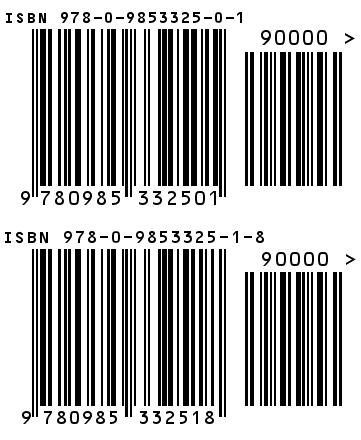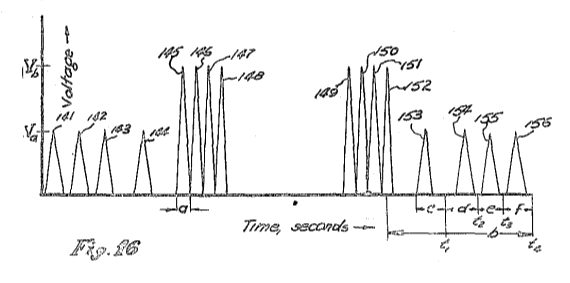Norman J. Woodland, Co-Inventor of the Barcode
December 17, 2012
Barcodes have been with us so long that it's hard to remember a time without them. They've made shopping more pleasant for both
customers and
clerks. My two
novels have barcodes on their back
covers, the registration for which cost me a little bit of money; but, now I'm a "real"
author, at least as far as the
Books In Print database is concerned.

Barcodes for my books, Mother Wode (top) and The Alchemists of Mars (bottom). These are in serial order, the last digit being a checksum digit.
Manipulating barcode images is somewhat tricky.
I tried to reduce the size of these for this example, but the interpolation method caused some of the white area to be filled as gray. This would be a problem for a barcode scanner)
I remember an article published in a
popular science magazine shortly after barcodes became ubiquitous. The
scientist author expressed amazement that his
receipt contained so much
information about the products he bought. He wondered how so much information could be contained in a small patch of thin and thick lines. The contained
code is just a
record number in a database from which all other information is pulled.
The barcode was
invented by
Norman J. Woodland and
Bernard Silver and
patented in 1952.[1] As a good example of an idea before its time, the patent made just $15,000 for its
inventors, and we can see why. The invention was demonstrated using
vacuum tubes and a non-
laser light source. The principal
embodiment had barcoded items travelling on a
transparent conveyor belt.
Maintenance of such a belt would be problematic.
Barcodes became feasible after other
technologies advanced. The
transistor was invented in 1947, and was not commercially viable until many years later. The
visible red light helium-neon laser was invented in 1962. The real key to a functional barcode system, an inexpensive
computer, wasn't realized until about 1975.
Mechanical engineer, Norman J. Woodland, who teamed with his
electrical engineer school mate,
Bernard Silver, to invent the barcode, died on December 9, 2012, at age 91.
Norman Woodland was born on September 6, 1921, in
Atlantic City. His learning
Morse Code as a
Boy Scout was a factor in his subsequent idea for the barcode.[2] He began studies at The Drexel Institute of Technology (now,
Drexel University), but these were interrupted by
World War II. During the war, Woodland worked at
Oak Ridge National Laboratory as a
technician on the
Manhattan Project.[2,3] After the war, he received his
bachelor's degree from Drexel in 1947.[2] He eventually continued his studies, receiving a
master's degree from
Syracuse University.[2-3]
One interesting
anecdote from Woodland's early life was an invention he conceived as an
undergraduate. He devised a method for
recording fifteen tracks of
music on
35-mm film. This was an advance in the current state-of-the-art in "
elevator music" systems. His father, however, was convinced that the elevator music industry was controlled by
organized crime, and discouraged his son from commercializing his invention.[2] This early venture into an
optical-
mechanical system may have aided his invention of barcodes.[2]
Bernard Silver became interested in product identification technologies when a
supermarket executive visited Drexel and introduced the problem to a
dean. Silver interested Woodland in the project, and their first idea was to use
fluorescent inks excited by
ultraviolet light.[2] Woodland became so interested in the problem that he quit graduate school at Drezel to work full time on the problem. In the
winter of 1948-1949, Woodland stayed with his grandparents in
Miami Beach.[2]
Woodland had his
Eureka moment while relaxing at the beach. In an article in the
Smithsonian magazine, as quoted by the
BBC and
The New York Times, Woodland explained,
"I poked my four fingers into the sand and for whatever reason - I didn’t know - I pulled my hand toward me and drew four lines. I said: 'Golly! Now I have four lines, and they could be wide lines and narrow lines instead of dots and dashes... Only seconds later, I took my four fingers - they were still in the sand - and I swept them around into a full circle."[2,4]
The
circular scheme had the advantage that the codes could be read at any orientation, and that scheme was the one that was patented. Among the various difficulties with the original idea was that a practical implementation needed a 500
watt light.[2] The patent was eventually sold to
Philco for $15,000,[2,4] but Woodland kept pitching the idea at
IBM, where he worked from 1951-1987.[2,4] It was likely the expiration of the original patent, along with technological advances, that finally encouraged IBM to further develop barcodes.

Figure sixteen of US Patent No. 2,612,994, "Classifying Apparatus And Method," by Norman J. Woodland and Bernard Silver, October 7, 1952. This shows the temporal readout of thin and thick bars. (Via Google Patents))
In the early 1970s, the code was standardized in its present
rectangular format, and the first product scanned, at a supermarket in
Troy, Ohio, was a $0.67 pack of
Wrigley's chewing gum.[2-5] One interesting anecdote from those early days was that
wine manufacturers refused to place the ugly marking on their
artistic labels.[5]
Woodland received the
National Medal of Technology and Innovation in 1992.[2,3] Woodland, along with Silver, who died in 1963, were inducted into the
National Inventors Hall of Fame in 2011.[2-4] According to the agency that administers the
Universal Product Code (UPC), there are more than five million registered barcodes worldwide.[4,5]
References:
-
Norman J. Woodland and Bernard Silver, "Classifying Apparatus And Method," US Patent No. 2,612,994, October 7, 1952.
- Margalit Fox, "N. Joseph Woodland, 1921-2012, If It’s for Sale, His Lines Sort It," The New York Times, December 12, 2012.
- N. Joseph Woodland dies at 91; co-inventor of bar code, Los Angeles Times, December 14, 2012.
- Barcode co-inventor Norman Joseph Woodland dies aged 91, BBC News, December 13, 2012.
- Zoe Kleinman, "Barcode birthday: 60 years since patent," BBC News, October 6, 2012.
Permanent Link to this article
Linked Keywords: Barcodes; customer; clerk; novel; cover; author; Books In Print; database; Mother Wode; The Alchemists of Mars; check digit; checksum digit; interpolation; barcode scanner; popular science; magazine; scientist; receipt; information; code; record number; invention; Norman J. Woodland; Bernard Silver; patent; inventor; vacuum tube; laser; light source; embodiment; transparent; conveyor belt; maintenance; technology; transistor; visible red light; helium-neon laser; computer; mechanical engineer; electrical engineer; Bernard Silver; Atlantic City, New Jersey; Morse Code; Boy Scout; Drexel University; World War II; Oak Ridge National Laboratory; technician; Manhattan Project; bachelor's degree; master's degree; Syracuse University; anecdote; undergraduate; multitrack recording; music; 35-mm film; elevator music; organized crime; optical; mechanical system; supermarket; executive; dean; fluorescence; fluorescent; ink; ultraviolet light; winter; Miami Beach, Florida; Eureka moment; Smithsonian magazine; BBC; The New York Times; circular; watt; Philco; IBM; rectangular; Troy, Ohio; Wrigley Company; chewing gum; wine; vintner; manufacturer; artistic; National Medal of Technology and Innovation; National Inventors Hall of Fame; Universal Product Code; US Patent No. 2,612,994.